Shedding Light on Increasing Trends of Phosphorus Concentration in Upper Austrian Rivers
Abstract
:1. Introduction
2. Materials and Methods
2.1. Case Study
2.2. Trend Analysis
2.3. Novel Approach to Input Data Management
2.4. MONERIS Model
2.5. Uncertainty and Sensitivity Analysis
3. Results
3.1. Trends of Phosphorus Concentrations in Surface Waters
3.2. Comparison of Observed and Modelled TP Concentrations in Selected Catchments
3.3. Identification of the Causes for Changes of TP Concentration in Selected Sub-Catchments
3.4. Discussion
Acknowledgments
Author Contributions
Conflicts of Interest
Abbreviations
| P | phosphorus |
| PP | particular phosphorus |
| SRP | soluble reactive phosphorus |
| TP | total phosphorus |
| WWTP | wastewater treatment plant |
References
- Shigaki, F.; Sharpley, A.; Prochnow, L.I. Animal-based agriculture, phosphorus management and water quality in Brazil: Options for the future. Sci. Agricola 2006, 63, 194–209. [Google Scholar] [CrossRef]
- Wang, X. Management of agricultural nonpoint source pollution in China: Current status and challenges. Water Sci. Technol. 2006, 53, 1–9. [Google Scholar] [CrossRef] [PubMed]
- Dubrovsky, N.M.; Burow, K.R.; Clark, G.M.; Gronberg, J.M.; Hamilton, P.A.; Hitt, K.J.; Mueller, D.K.; Munn, M.D.; Nolan, B.T.; Puckett, L.J.; et al. The Quality of our Nation’s Waters-Nutrients in the Nation’s Streams and Groundwater, 1992–2004. Circular 1350; US Geological Survey, Ed.; US Geological Survey: Sacramento, CA, USA, 2010.
- Novotny, V.; Wang, X.; Englande, A.J., Jr.; Bedoya, D.; Promakasikorn, L.; Tirado, R. Comparative assessment of pollution by the use of industrial agricultural fertilizers in four rapidly developing Asian countries. Environ. Dev. Sustain. 2010, 12, 491–509. [Google Scholar] [CrossRef]
- EU. Directive 2000/60/EC of the European Parliament and of the Council Establishing a Framework for the Community Action in the Field of Water Policy. Available online: http://ec.europa.eu/environment/water/water-framework/index_en.html (accessed on 14 September 2016).
- EEA. European Waters—Assessment of Status and Pressures; Technical Report; European Environment Agency: Copenhagen, Denmark, 2012. [Google Scholar]
- ICPDR. The Danube River Basin District Management Plan—Update 2015; Technical Report; International Commission for the Protection of the Danube River: Vienna, Austria, 2015. [Google Scholar]
- Sharpley, A.N.; Bergström, L.; Aronsson, H.; Bechmann, M.; Bolster, C.H.; Börling, K.; Djodjic, F.; Jarvie, H.P.; Schoumans, O.F.; Stamm, C.; et al. Future agriculture with minimized phosphorus losses to waters: Research needs and direction. AMBIO 2015, 44, 163–179. [Google Scholar] [CrossRef] [PubMed]
- Behrendt, H.; Huber, P.; Kornmilch, M.; Opitz, D.; Schmoll, O.; Scholz, G.; Uebe, R. Nutrient Emissions into River Basins of Germany; Technical Report, UBA-Texte 23/00; Federal Environmental Agency: Berlin, Germany, 2000; p. 266.
- Behrendt, H.; Kornmilch, M.; Opitz, D.; Schmoll, O.; Scholz, G. Estimation of the nutrient inputs into river systems–experiences from German rivers. Reg. Environ. Chang. 2002, 3, 107–117. [Google Scholar] [CrossRef]
- Venohr, M.; Hirt, U.; Hofmann, J.; Gericke, A.; Wetzig, A.; Natho, S.; Neumann, F.; Hürdler, J.; Matranga, M.; Mahnkopf, J. Modelling of nutrient emissions in river systems–MONERIS–methods and background. Int. Rev. Hydrobiol. 2011, 96, 435–483. [Google Scholar] [CrossRef]
- Zweinert, U. Möglichkeiten und Grenzen bei der Modellierung von Nährstoffeinträgen auf Flussgebietsebene—Untersuchungen am Beispiel des Modells MONERIS. Ph.D. Thesis, Technische Universität Dresden, Dresden, Germany, 2008. [Google Scholar]
- Schreiber, H.; Behrendt, H.; Constantinescu, L.T.; Zessner, M. Point and diffuse nutrient emissions and loads in the transboundary Danube River Basin. I. A modelling approach. Archiv für Hydrobiologie. Supplementband. Large Rivers 2005, 16, 221–247. [Google Scholar]
- Behrendt, H.; van Gils, J.; Schreiber, H.; Zessner, M. Point and diffuse nutrient emissions and loads in the transboundary Danube River Basin. II. Long-term changes. Archiv für Hydrobiologie. Supplementband. Large Rivers 2005, 16, 221–247. [Google Scholar]
- Zessner, M.; Gabriel, O.; Kovacs, A.; Kuderna, M.; Schilling, C.; Hochedlinger, G.; Windhofer, G. Analyse der Nährstoffströme in Oberösterreichischen Einzugsgebieten nach Unterschiedlichen Eintragspfaden für Strategische Planungen (Nährstoffströme Oberösterreich); Technical Report; Im Auftrag des Amtes der Oberösterreichischen Landesregierung: Vienna, Austria, 2011. [Google Scholar]
- Zessner, M.; Gabriel, O.; Kovacs, A.; Kuderna, M.; Schilling, C.; Hochedlinger, G.; Windhofer, G. Analyse der Wirkung von Maßnahmen zur Reduktion von Nährstoffeinträgen in Oberösterreichischen Einzugsgebieten nach Unterschiedlichen Eintragspfaden für Strategische Planungen; Technical Report; Im Auftrag des Amtes der Oberösterreichischen Landesregierung: Vienna, Austria, 2012. [Google Scholar]
- Zessner, M.; Gabriel, O.; Kuderna, M.; Weinberger, C.; Hepp, G.; Kovacs, A.; Windhofer, G. Effektivität von Maßnahmen zur Reduktion der Phosphorbelastung der oberösterreichischen Fließgewässer. Österreichische Wasser- und Abfallwirtschaft 2013, 66, 51–58. [Google Scholar] [CrossRef]
- Zessner, M.; Hepp, G.; Kuderna, M.; Weinberger, C.; Gabriel, O.; Windhofer, G. Konzipierung und Ausrichtung übergeordneter Strategischer Maßnahmen zur Reduktion von Nährstoffeinträgen in Oberösterreichische Fließgewässer; Technical Report; Im Auftrag des Amtes der Oberösterreichischen Landesregierung: Vienna, Austria, 2014. [Google Scholar]
- Mann, O.B. Nonparametric tests against trend. Econometrica 1945, 13, 245–259. [Google Scholar] [CrossRef]
- Kendall, M.G. Rank Correlation Methods; Griffin, Ed.; C. Griffin: Harpers Ferry, WV, USA, 1948. [Google Scholar]
- Helsel, D.R.; Hirsch, R.M. Statistical Methods in Water Resources; US Geological Survey, Ed.; US Geological Survey: Sacramento, CA, USA, 2002. [Google Scholar]
- Theil, H. A rank-invariant method of linear and polynomial regression analysis. 1, 2 and 3. Nederl. Akad. Wetensch. Proc. 1950, 53, 386–392, 521–525, 1397–1412. [Google Scholar]
- Sen, P.K. Estimates of the regression coefficient based on Kendall‘s tau. J. Am. Stat. Assoc. 1968, 63, 1379–1389. [Google Scholar] [CrossRef]
- Zessner, M.; Kroiss, H. Retention and losses of nutrients in the hydrosphere of Austria. Water Sci. Technol. 1999, 40, 59–66. [Google Scholar] [CrossRef]
- Hirsch, R.M.; Alexander, R.B.; Smith, R.A. Selection of methods for the detection and estimation of trends in water quality. Water Resour. Res. 1991, 27, 803–813. [Google Scholar] [CrossRef]
- Hirsch, R.M.; Slack, J.R.; Smith, R.A. Techniques of trend analysis for monthly water quality data. Water Resour. Res. 1982, 18, 107–121. [Google Scholar] [CrossRef]
- BMLFUW. WISA Wasser Informationsystem Austria—H2O Fachdatenbank. Available online: https://wasser.umweltbundesamt.at/h2odb/ (accessed on 14 September 2016).
- Upper Austria Government. AIM Amtliches Immissionsmessnetz. Available online: https://www.land-oberoesterreich.gv.at/163846.htm (accessed on 14 September 2016).
- R Core Team. R: A Language and Environment for Statistical Computing. 2016. [Google Scholar]
- BMLFUW. Invekos Database. Available online: https://www.bmlfuw.gv.at/land/direktzahlungen/Invekos.html (accessed on 14 September 2016).
- Schwertmann, U.; Vogl, W.; Kainz, M. Bodenerosion durch Wasser—Vorhersage des Abtrags und Bewertung von Gegenmaßnahmen; Verlag Eugen Ulmer: Stuttgart, Germany, 1987. [Google Scholar]
- Zessner, M.; Kovacs, A.; Schilling, C.; Hochedlinger, G.; Gabriel, O.; Natho, S.; Thaler, S.; Windhofer, G. Enhancement of the MONERIS model for application in alpine catchments in Austria. Int. Rev. Hydrobiol. 2011, 96, 541–560. [Google Scholar] [CrossRef]
- Schilling, C.; Zessner, M.; Kovacs, A.; Hochedlinger, G.; Windhofer, G.; Gabriel, O.; Thaler, S.; Parajka, J.; Natho, S. Stickstoff- und Phosphorbelastungen der Fließgewässer Österreichs und Möglichkeiten zu deren Reduktion. Österreichische Wasser- und Abfallwirtschaft 2011, 63, 105–116. [Google Scholar] [CrossRef]
- BMLFUW. ÖPUL 2000. Sonderrichtlinie für das Österreichische Program zur Förderung einer Umweltgerechten, Extensiven und den Natürlichen Lebensraum Schützenden Landwirtschaft. Available online: https://www.bmlfuw.gv.at/land/laendl_entwicklung/oepul.html (accessed on 14 September 2016).
- BMLFUW. ÖPUL 2007. Sonderrichtlinie für das Österreichische Program zur Förderung einer Umweltgerechten, Extensiven und den Natürlichen Lebensraum Schützenden Landwirtschaft. Available online: https://www.bmlfuw.gv.at/land/laendl_entwicklung/oepul.html (accessed on 14 September 2016).
- wpa Beratende Ingenieure. Abschätzung des Bodenabtrags in Österreich und Integration der Daten in der INVEKOS Datenbank; Technical Report; Bundesministerium für Land- und Forstwirtschaft, Umwelt und Wasserwirtschaft: Wien, Austria, 2009. [Google Scholar]
- BMLFUW. Gewässerschutzbericht 1996; Technical Report; Bundesministerium für Land- und Forstwirtschaft, Umwelt und Wasserwirtschaft, Lebensministerium: Vienna, Austria, 1996. [Google Scholar]
- BMLFUW. Kommunale Abwasserrichtlinie der EU—91/271/EWG. Österreichischer Bericht 2008; Technical Report; Bundesministerium für Land- und Forstwirtschaft, Umwelt und Wasserwirtschaft, Lebensministerium: Vienna, Austria, 2008. [Google Scholar]
- Jarvie, H.P.; Neal, C.; Withers, P.J.A. Sewage-effluent phosphorus: A greater risk to river eutrophication than agricultural phosphorus? Sci. Total Environ. 2006, 360, 246–253. [Google Scholar] [CrossRef] [PubMed]
- BMLFUW. Kommunale Abwasserrichtlinie der EU—91/271/EWG. Österreichischer Bericht 2014; Technical Report; Bundesministerium für Land- und Forstwirtschaft, Umwelt und Wasserwirtschaft, Lebensministerium: Vienna, Austria, 2014. [Google Scholar]
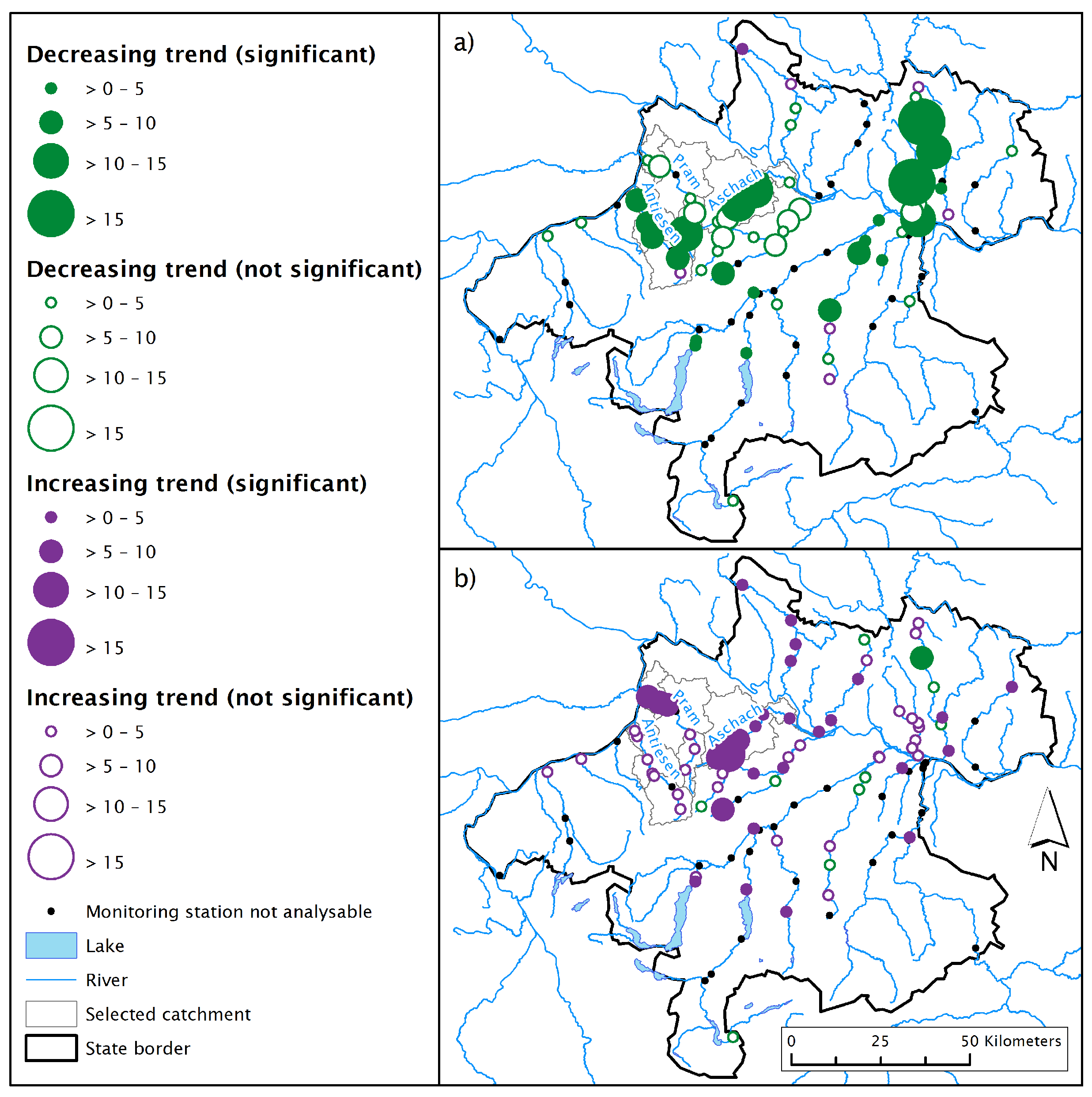
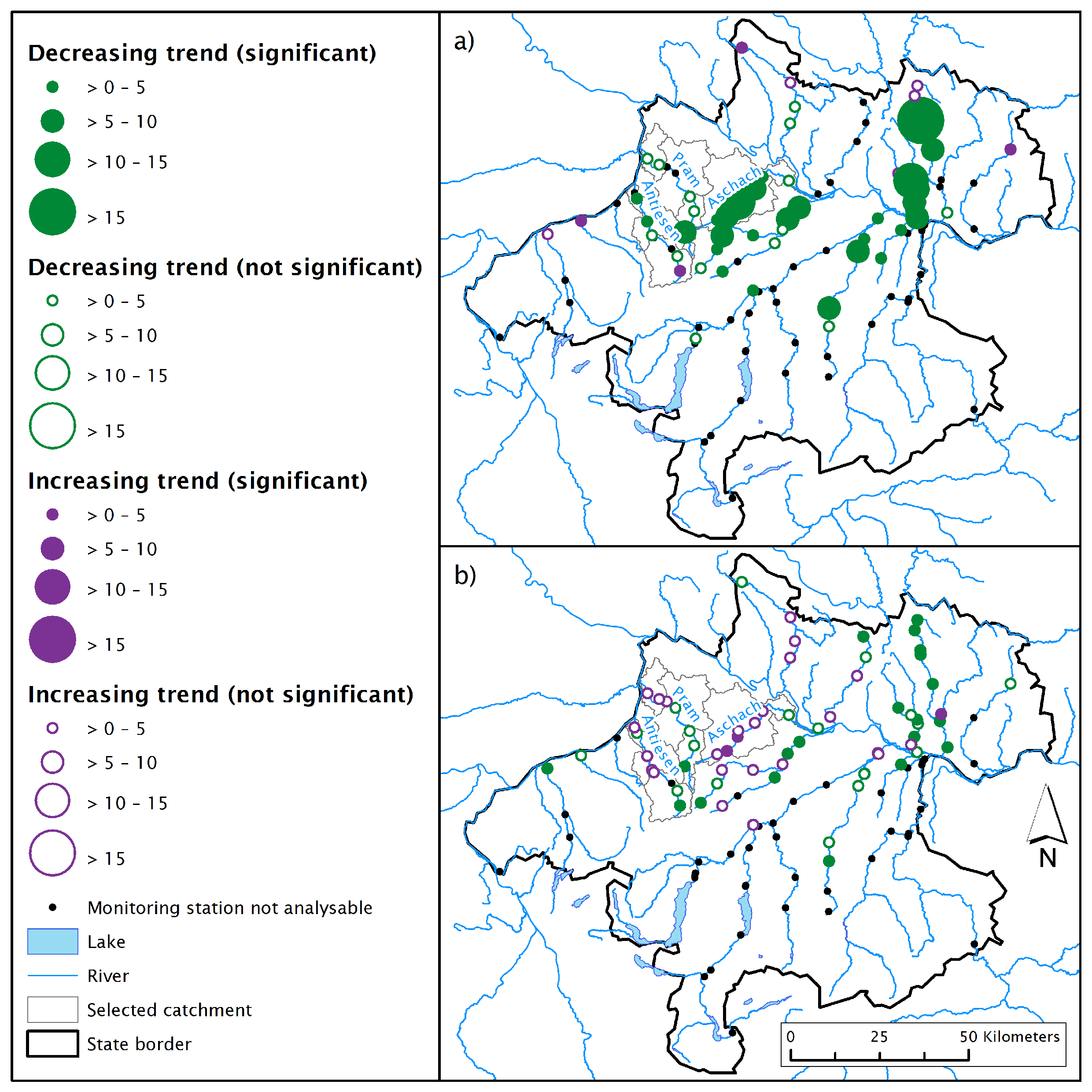
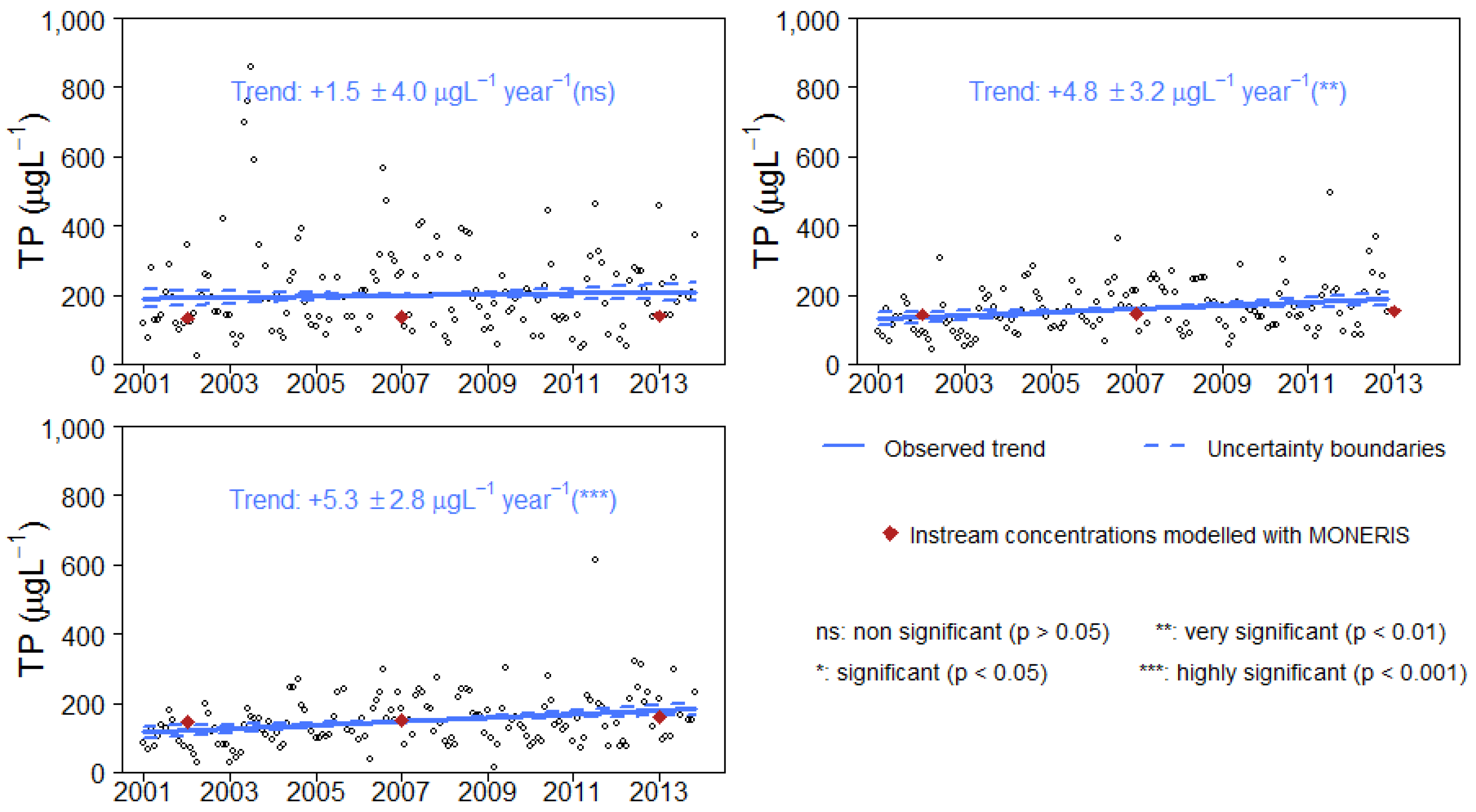
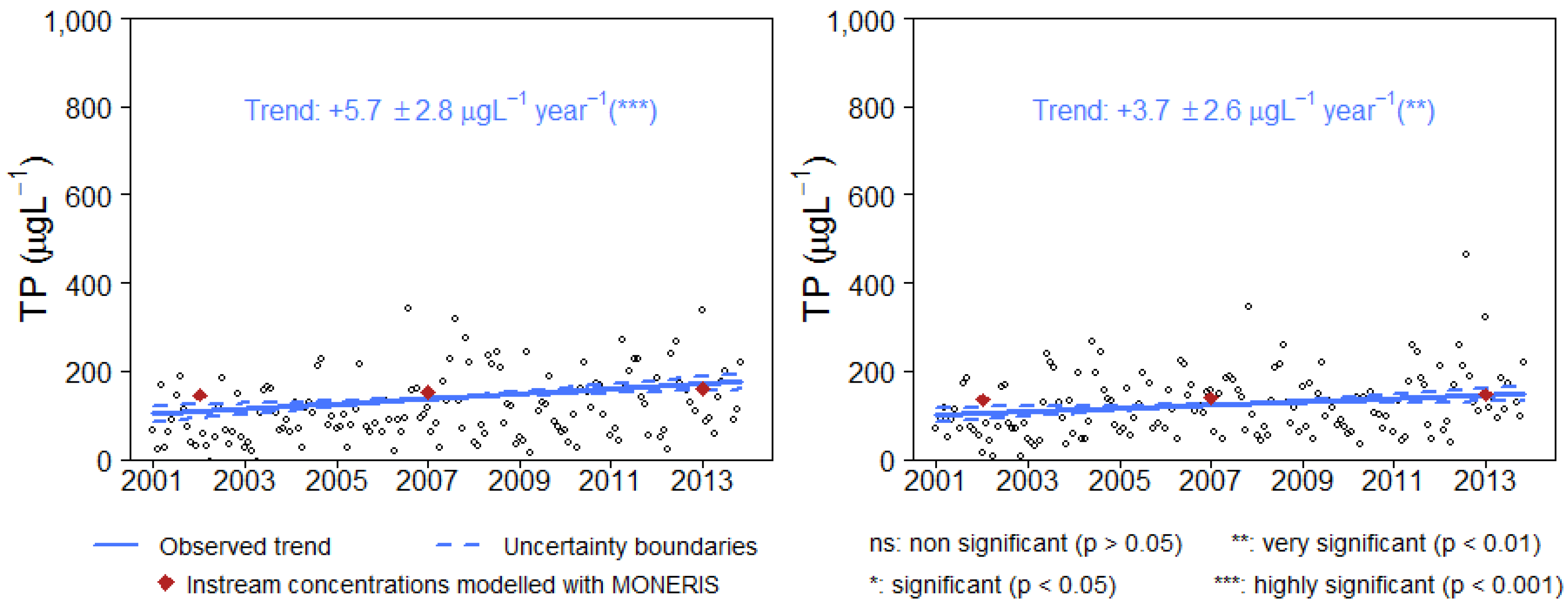
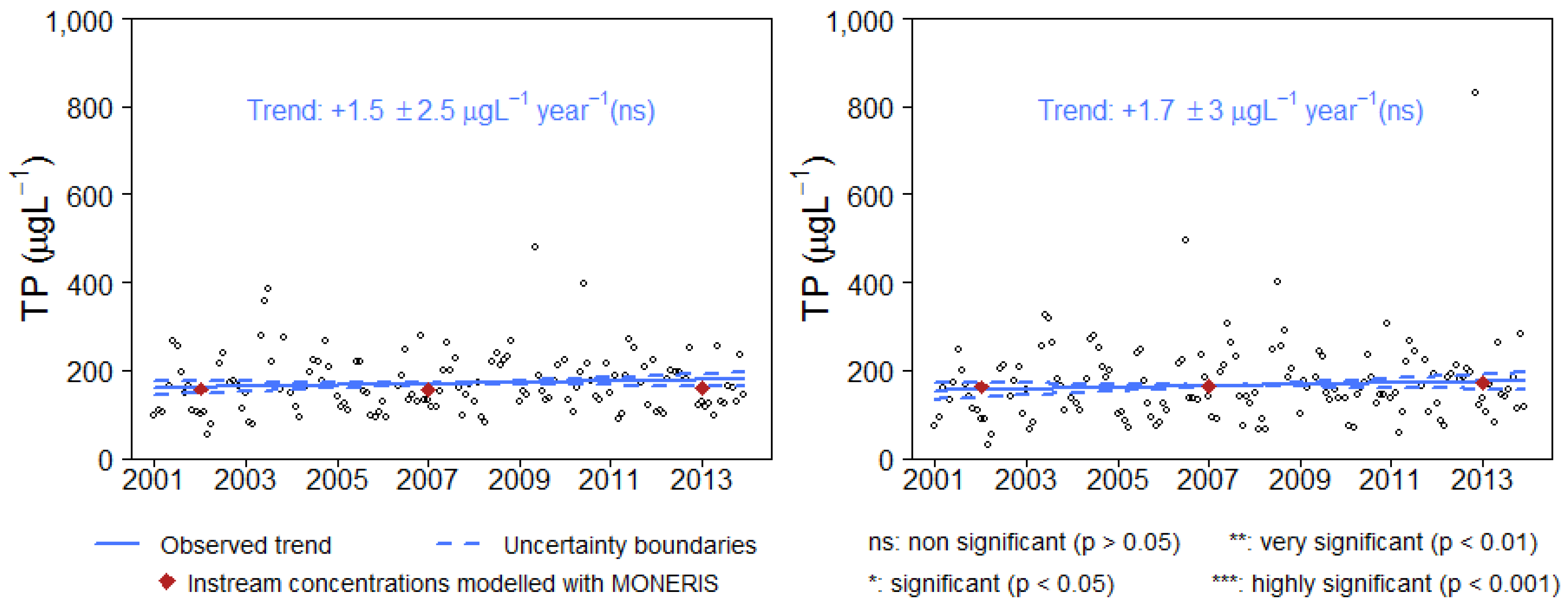
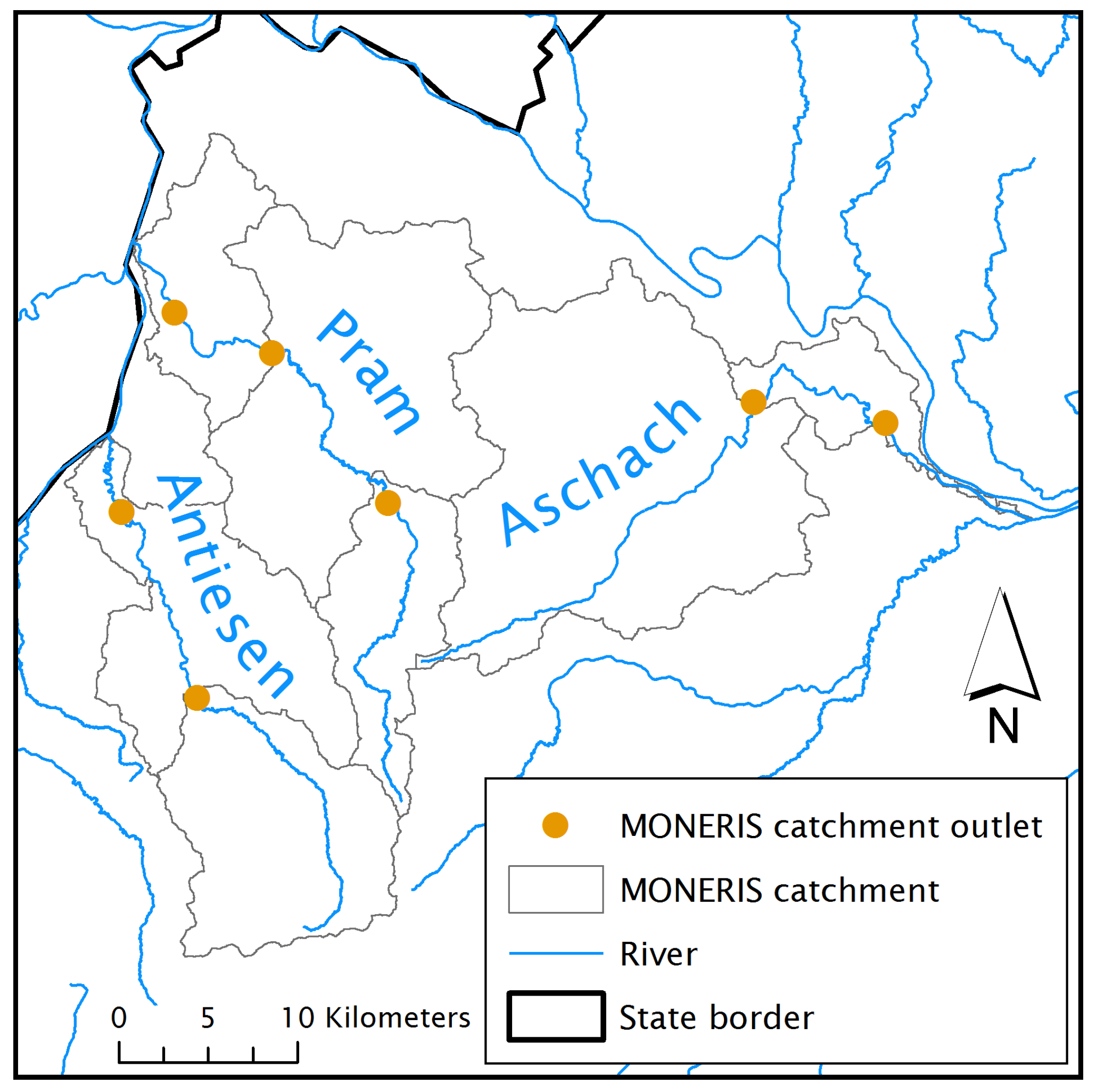
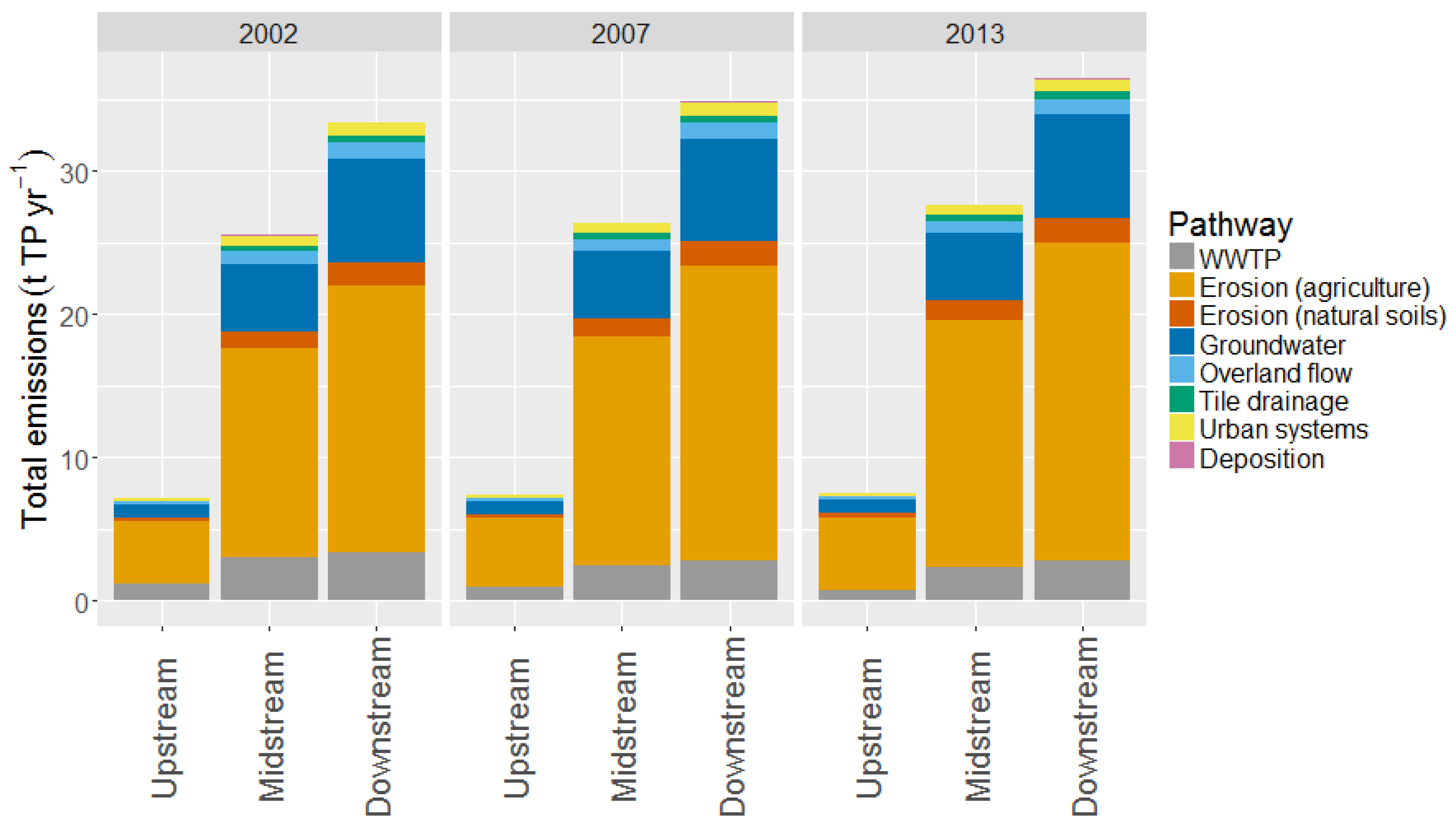
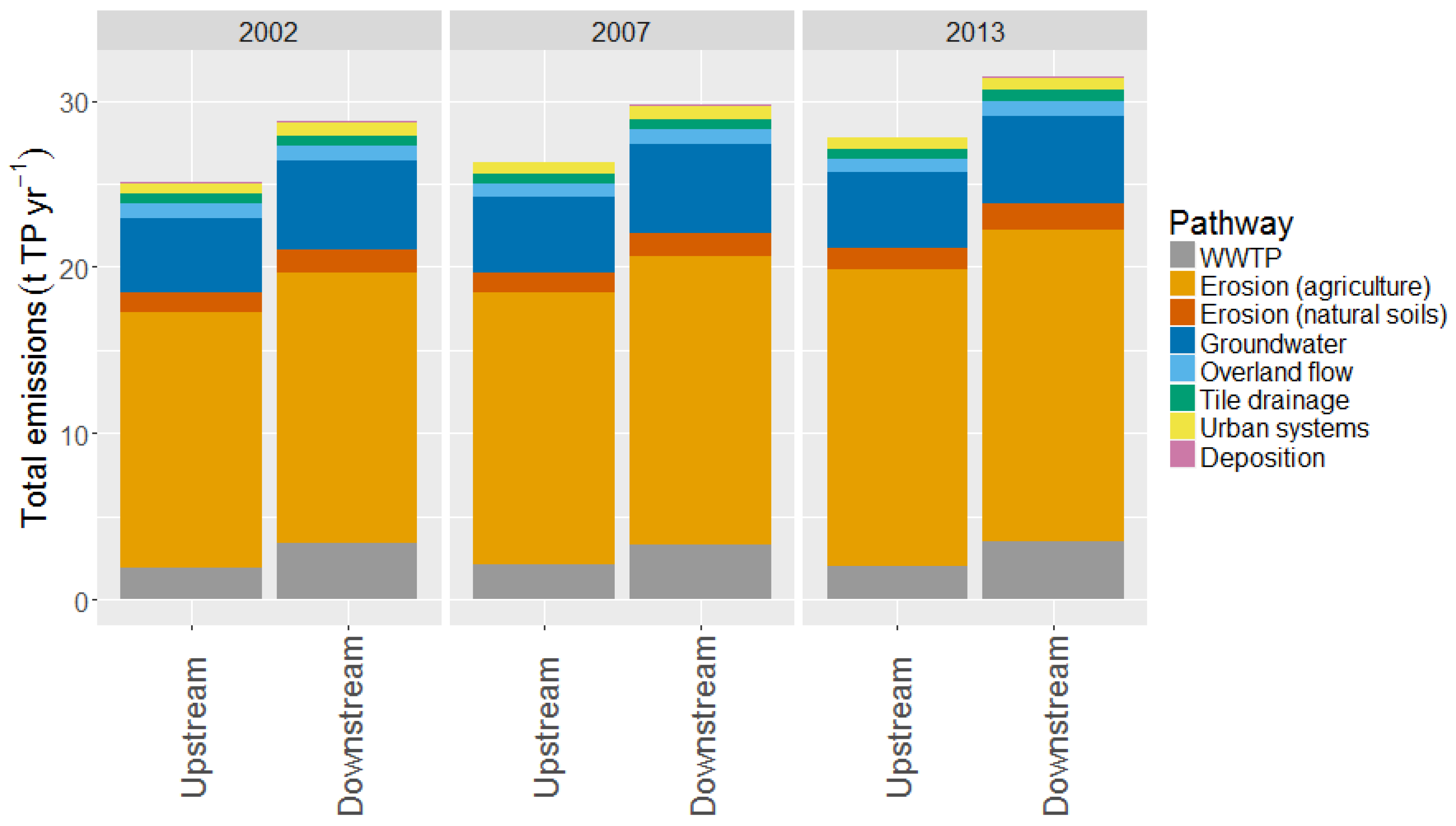
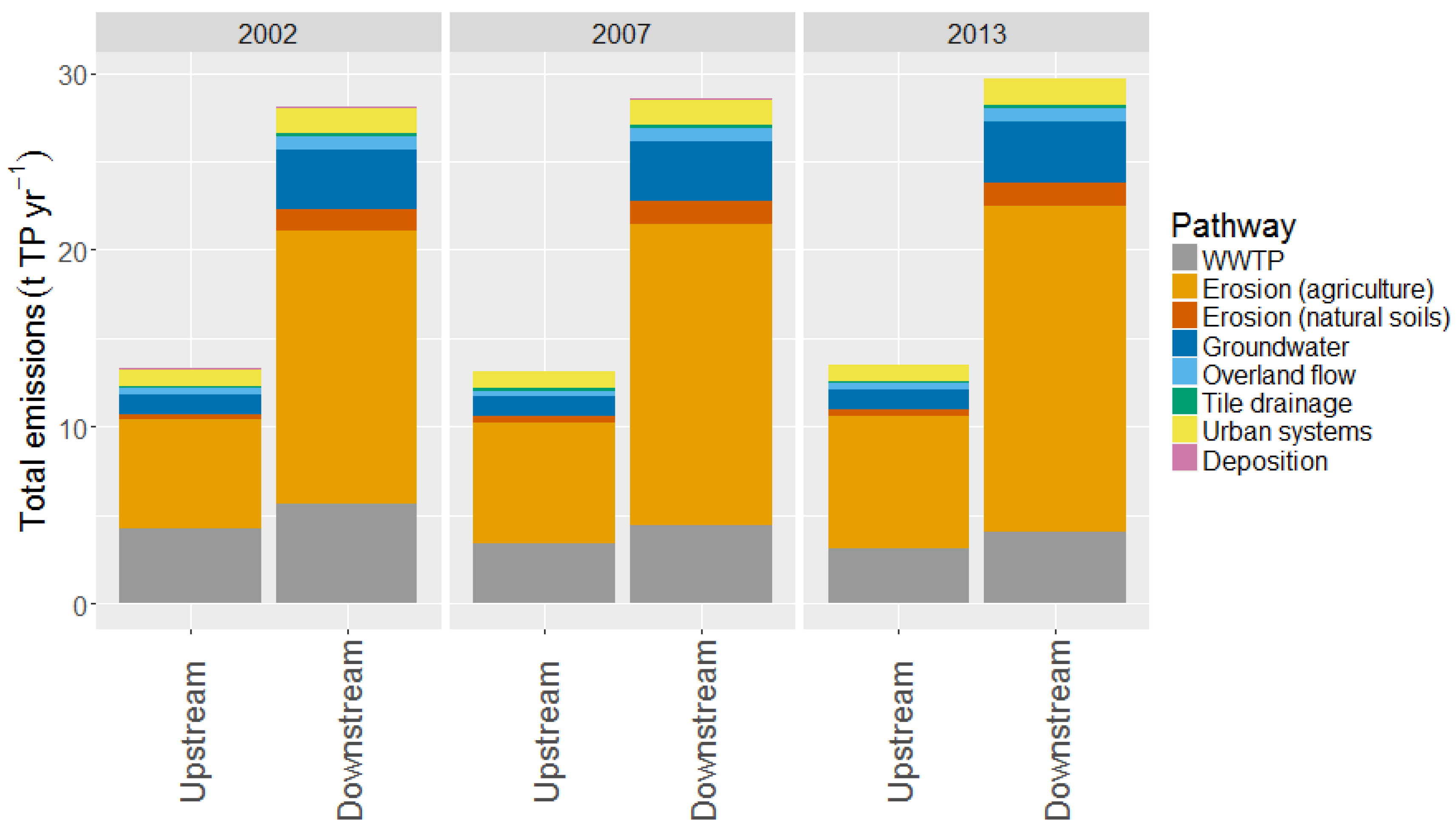
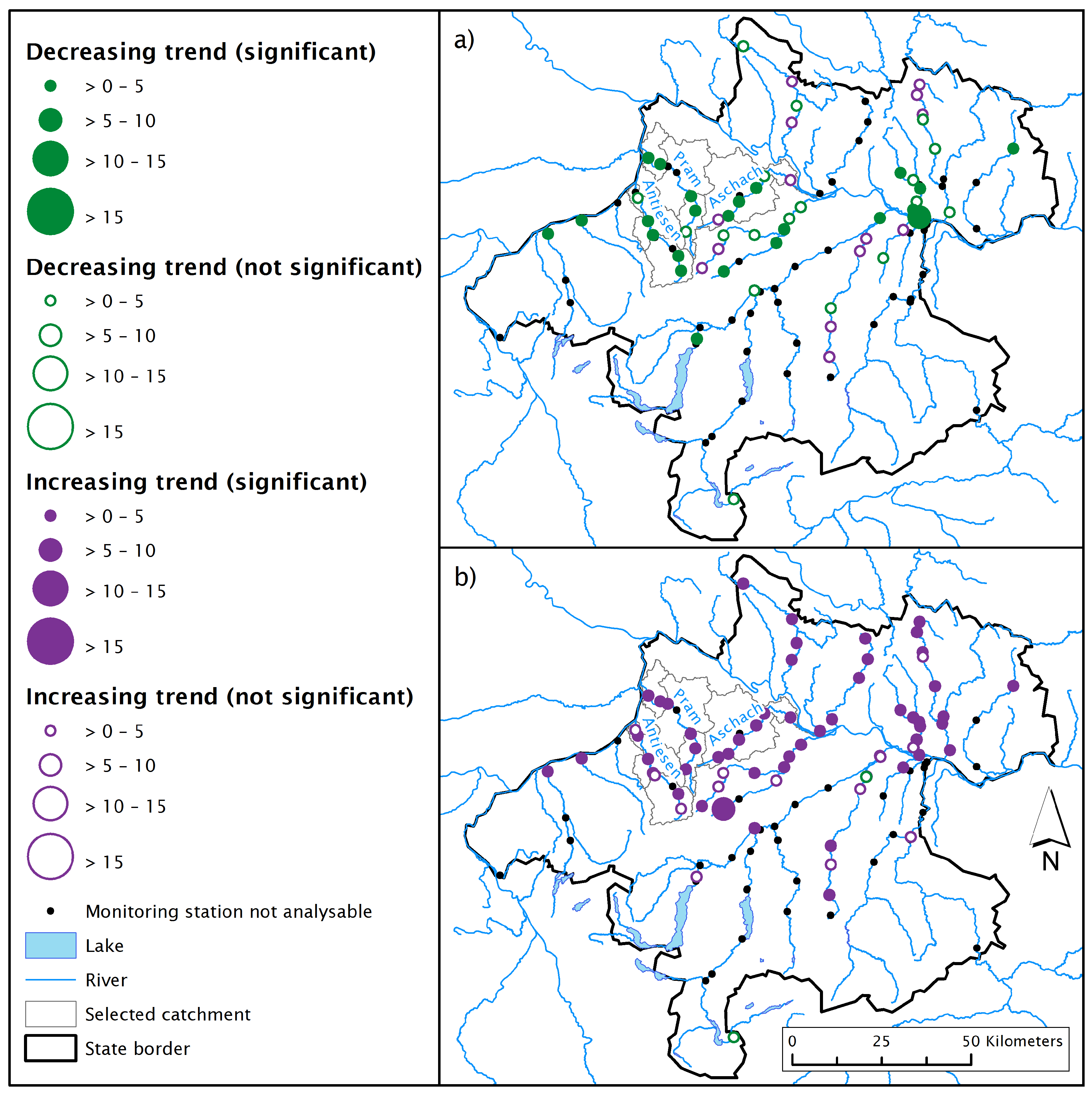
| Temporal Change (±μg TP−1 year−1) | 2001–2013 | |
|---|---|---|
| Observed Trend | Modelled Trend | |
| Pram upstream | +1.5 ± 4.0 (ns) | +0.5 ± 0.5 |
| Pram midstream | +4.8 ± 3.2 (**) | +1.0 ± 0.5 |
| Pram downstream | +5.3 ± 2.8 (***) | +1.2 ± 0.5 |
| Aschach upstream | +5.7 ± 2.8 (***) | +1.4 ± 0.4 |
| Aschach downstream | +3.7 ± 2.6 (**) | +1.1 ± 0.4 |
| Antiesen upstream | +1.5 ± 2.5 (ns) | +0.3 ± 0.6 |
| Antiesen downstream | +1.7 ± 3.0 (ns) | +0.7 ± 0.6 |
© 2016 by the authors; licensee MDPI, Basel, Switzerland. This article is an open access article distributed under the terms and conditions of the Creative Commons Attribution (CC-BY) license (http://creativecommons.org/licenses/by/4.0/).
Share and Cite
Zessner, M.; Zoboli, O.; Hepp, G.; Kuderna, M.; Weinberger, C.; Gabriel, O. Shedding Light on Increasing Trends of Phosphorus Concentration in Upper Austrian Rivers. Water 2016, 8, 404. https://doi.org/10.3390/w8090404
Zessner M, Zoboli O, Hepp G, Kuderna M, Weinberger C, Gabriel O. Shedding Light on Increasing Trends of Phosphorus Concentration in Upper Austrian Rivers. Water. 2016; 8(9):404. https://doi.org/10.3390/w8090404
Chicago/Turabian StyleZessner, Matthias, Ottavia Zoboli, Gerold Hepp, Max Kuderna, Christine Weinberger, and Oliver Gabriel. 2016. "Shedding Light on Increasing Trends of Phosphorus Concentration in Upper Austrian Rivers" Water 8, no. 9: 404. https://doi.org/10.3390/w8090404
APA StyleZessner, M., Zoboli, O., Hepp, G., Kuderna, M., Weinberger, C., & Gabriel, O. (2016). Shedding Light on Increasing Trends of Phosphorus Concentration in Upper Austrian Rivers. Water, 8(9), 404. https://doi.org/10.3390/w8090404







